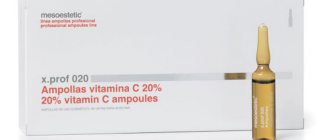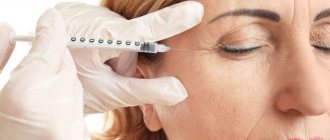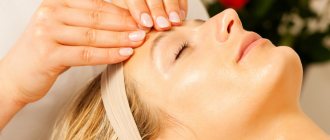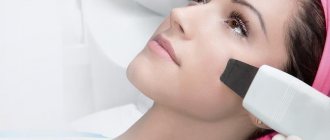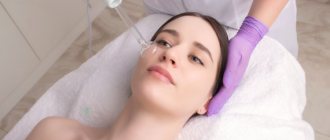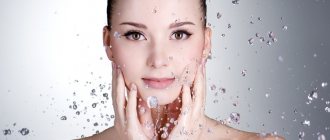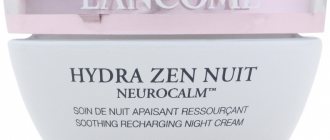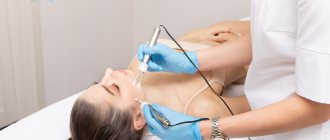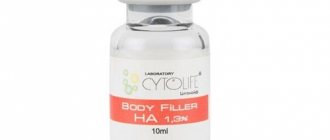Peptides are the newest word in modern cosmetology. These tiny molecules, consisting of different sequences of amino acids, play a huge role in various regulatory processes. There are a huge number of peptides, and today not all have been studied and known to man. However, their role is enormous, and if we learn to influence the finest mechanisms through regulation, we will be able to achieve great results.
In this article we will look at peptides used specifically in injection cosmetology and the preparations in which they are presented.
What are the features of peptide mesotherapy?
Peptides are a protein substance whose functions are to regulate the physiological processes of the body. Their properties depend on their primary structure and can be different. For example, endorphins and leptins regulate appetite, and bradykinin is “responsible” for vascular tone. By correctly selecting synthesized peptides and introducing them into problem areas, you can achieve enhanced skin rejuvenation, eliminate hyperpigmentation and other skin defects not only on the face, but also on other parts of the body. Peptide mesotherapy allows:
- get the first noticeable results after the first procedure;
- eliminate wrinkles and provide a lifting effect;
- normalize the condition of oily or dry skin;
- eliminate sagging skin;
- make skin cells more resistant to oxygen deficiency;
- eliminate bruises and swelling under the eyes;
- restore healthy complexion.
It is no coincidence that the procedure is considered one of the optimal methods of rejuvenation: it can trigger cell regeneration in a natural way, so the results will be excellent.
What do peptides do for the skin?
- Stabilize and support the processes of cell restoration and renewal.
- Maintains optimal rate of cell division.
- Stimulate fibroblasts and the synthesis of dermal matrix components (collagen, elastin, hyaluronic acid).
- Strengthens collagen and elastin fibers.
- Restores firmness and elasticity.
- Increases skin turgor and density.
- Tighten the oval of the face.
- Stimulate regeneration.
- Relaxes muscles.
- Smoothes out wrinkles, including facial wrinkles.
- They work to prevent premature skin aging.
- Strengthens the skin's antioxidant protection.
- Inhibits the inflammatory process.
- They heal.
- Strengthens lymphatic drainage, relieves swelling.
- Stimulate microcirculation.
- Reduces the manifestations of rosacea.
- Lighten pigmentation.
- Evens out complexion.
The properties of peptides - their ability to penetrate the skin, action and effectiveness - are determined by the sequence of amino acids in the chain. Little commanders have order everywhere - a specific peptide is responsible for each signal. Therefore, one product usually contains several peptides. The more functions a cream has, for example, the richer its filling and peptide composition will be.
Peptide “cocktails”: the result is obvious!
Modern pharmacology offers a wide range of products for peptide injections. Depending on the effect they have after administration, they are classified into drugs for the following types of effects:
- drainage;
- vascular;
- capillary.
When preparing meso-cocktails, our specialists always take into account the fact that some preparations are intended exclusively for the general improvement of the skin, others - to create a lifting effect, others - to strengthen, and others - to rejuvenate the skin around the eyes. That is why competent selection is so important, because it determines how manifest the desired result will be.
The advantages of using peptide mesococktails are as follows:
- effective even with atonic skin;
- the ability to correct all skin defects;
- tightening and smoothing wrinkles and facial folds of any intensity;
- rapid restoration of elastin balance;
- restoration of skin after previous procedures;
- elimination of scars and scars.
Facial mesotherapy with peptides allows you to make the skin elastic again without resorting to radical methods, which, in turn, eliminates stress for the body.
Dermaheal HSR
- Active components: hyaluronic acid, copper tripeptide, biomimetic peptides, minerals, a number of amino acids (serine, glycine, alanine, leucine, arginine, valine, lysine, isoleucine).
- Age category: used for patients over 40-45 years old.
- Therapeutic method: used in mesotherapy and biorevitalization procedures;
- Action: instant hydration, even out tone and microrelief, increase skin tone and elasticity, lifting (combat grade 1-2 gravitational ptosis), smooth out scars, eliminate stretch marks, narrow enlarged pores, treat acne, lighten dark circles under the eyes .
- Indications: the drug is indicated for patients with general signs of aging and fading of the skin, a lack of moisture in it, and a decrease in its elasticity. Used for severe dry skin, tendency to stretch marks, acne (not exacerbation).
Biorevitalization techniques using peptides
The effectiveness of the procedure depends not only on how correctly the drug was selected for it, but also on the technique of the procedure. Methods for performing injections with peptides are presented in the table below.
| Name of the technique | Features of application, advantages |
| Superficial nappage | Provides for the introduction of meso-cocktails of gel-like consistency to a depth of no more than 0.5 mm. Injection is carried out along massage lines and in increments of no more than 1 cm. The technique is used to treat the décolleté, neck and face areas. |
| Middle nappage | The technique involves the introduction of meso-cocktails to depths of 0.6 to 1.5 mm in increments of 1 to 2 cm. Injection is carried out along massage lines and is used to treat minor stretch marks, post-acne, rosacea and smoothing skin texture. |
| Deep nappage | The technique requires the introduction of meso-mixtures to a depth of up to 10 mm with a 13 mm long needle. When injecting, it is held at an angle of 90°. Deep nappage is used for cellulite or local fat deposits for the administration of lipolytic drugs. |
| Papular | Provides for the formation of papules of various diameters in order to achieve a prolonged effect. The injection is carried out to a depth of 1 to 2 mm (micropapules) or from 2 to 3 mm (medium papules). The drugs used can be anything. |
| Retrograde-linear | It is complex in execution, since it involves creating a groove in the skin and filling it with a drug during the process of withdrawing the needle. The technique is used to eliminate wrinkles, stretch marks and scars. |
Biorevitalization with peptides can also be carried out using a mesoscooter, which is a special device with spikes made of titanium for surgical purposes. Mesoscooters for the face have a needle length of up to 1 mm, for the body - up to 2 mm.
How is the peptide mesotherapy procedure performed?
A mesotherapy session using peptide includes the following:
- pre-treatment of the skin with an antiseptic;
- application of anesthetic;
- carrying out multiple injections;
- secondary treatment with an antiseptic;
- applying a soothing mask or cream.
Despite the fact that manual introduction of the meso-cocktail causes more trauma to the skin, it allows you to achieve a more pronounced result. This is due to the fact that when the skin is injured, regeneration processes are additionally launched.
Peptides that slow down enzymes.
These peptides work on the skin by inhibiting the activity of enzymes that destroy collagen, elastin and other proteins, and also stimulate excessive skin pigmentation. This type of peptide has the same principle of operation as retinol, so it can be called an alternative to products with retinoids for use in the summer.
2.1. Whitening peptides
MELANOSTATIN-5
It has a whitening effect due to the fact that it is an antagonist of alpha-melanocyte-stimulating hormone, as a result of which it prevents the influence of hormonal impulses on the activation of the process of melanin synthesis, evening out skin tone.
Revital (Renova, Italy)
Aurevitelli P.Nutrivive (Nefis, Spain)
Tetrapeptide-30 TEGO® PEP 4-EVEN
Eliminates pigment spots stimulated by UV rays and has a pronounced anti-inflammatory effect on irritated skin. Has antityrosinase activity.
Revital (Renova, Italy)
Oligopeptide-34 CG-TGP2 and Oligopeptide-24
Reduces the effect of melanocyte-stimulating hormone on melanocytes and the production (expression) of key molecules of melanogenesis, reduces the activity of tyrosinase, thereby blocking further reactions of melanin synthesis. Provides an anti-inflammatory effect by inhibiting the proliferation of activated T cells.
Aquashine (Caregen Co. Ltd, South Korea)
Dark Circle Solution (Caregen Co. Ltd, South Korea)
Recommendations after the procedure
Mesotherapy of the face and body with peptides requires not only the skill of a cosmetologist, but also the responsibility of the patient, who must strictly follow all the recommendations of her doctor. Thus, it will not only ensure complete absorption of the mesococktail, but will also minimize the risk of side effects and complications after the procedure.
So, during the first two to three days, it is necessary to wipe the treated area with antiseptic agents. For 48 hours, it is prohibited to apply decorative cosmetics to the treated area or massage it. For two weeks after the procedure, it is prohibited to visit baths and saunas or play sports.
Advantages and disadvantages
Peptides have many advantages:
- noticeably rejuvenate the skin;
- eliminate not only visible cosmetic problems, but also the source of the problem, penetrating into cells;
- are not addictive;
- have a prolonged effect;
- practically do not provoke allergies;
- Suitable for all skin types.
This therapy also has some disadvantages:
- presence of contraindications;
- the existence of special rules of care before and after the procedure;
- risk of complications;
- the need to carefully select a clinic, doctor and drug with peptides.
How is mesotherapy with peptides carried out at the Doctor Nearby clinic?
Hundreds of patients of our clinic have already experienced the effectiveness of this procedure. We pay special attention to compliance with all safety rules, therefore, before performing mesotherapy, we take all necessary measures to identify contraindications in patients.
The selection of meso-cocktails is carried out individually, taking into account the characteristics of the skin, the assigned tasks and the age of the patient. The technique of introducing the product into the problem area is selected in the same way.
The procedure is carried out under sterile conditions, using certified drugs and observing international standards by experienced, highly qualified specialists. After the procedure, the staff observes the patient’s reaction to the injected drugs for half an hour - and only after that he is sent home.
Trust your beauty and health to the professional cosmetologists of the Doctor Nearby clinic!
Patient reviews
Patients also respond well to peptide biorevitalization and mesotherapy.
Like doctors, users primarily share their impressions of specific peptide products.
The author of this review was satisfied with REVI biorevitalizant. According to the 33-year-old woman, the skin becomes more hydrated and the complexion improves.
Here, a user praises the Meso-Wharton P199 peptide drug.
This woman (40 years old), on the contrary, was dissatisfied with the drug with Meso-Wharton P199 peptides. Moreover, she performed the procedure in a clinic with a good reputation. The doctor observed all precautions, but apparently did not warn the patient about possible allergic reactions.
Biorevitalization and mesotherapy with peptides are effective procedures that improve the condition of the skin and slow down its aging. Of course, unpredictable reactions of the body are possible, so it is important to choose an experienced doctor and a high-quality drug. If you are afraid of injections, maintain youthful skin with cosmetics with peptides. These substances are also found in protein foods - meat, cereals, milk, kefir and cottage cheese, fish, legumes, and especially in soybeans.
Tripeptide
For example, tripeptide
.
The history of this peptide began in 1973. Scientist Lauren Picart decided to test what would happen if blood plasma taken from young people was added to the liver cells of older people. He saw that under the influence of young plasma, liver cells begin to synthesize proteins characteristic of young cells. By successively removing proteins and peptides from the plasma, the scientist was able to establish that this effect is produced by a tripeptide (glycine-histidine-lysine)
.
Later it became known that the tripeptide has a high affinity for copper and can be present in the body in the form of a complex with copper. To date, this peptide has been proven effective in healing wounds and improving the characteristics of aging skin.
| It was also possible to establish that when treating wounds with preparations containing this tripeptide or its complex with copper, enlarged hair follicles appear along the periphery of the wounds . There are drugs to combat hair loss based on the tripeptide in the form of its complex with copper. Their effectiveness is based on the ability of this peptide to restore the functionality of damaged skin cells and support the reparative potential of stem cells. As it turned out, this peptide is active in low concentrations, it has been studied in detail, which makes it a fairly effective component for cosmetic hair products. |
Cosmetic preparations with peptides for face and body care
For the first time, peptide-containing cosmetics began to be used in the 70s of the 20th century, after methods for storing peptides were found. The invention belonged to Dr. Warburg from Switzerland. After a series of experiments that confirmed the effectiveness of the innovation, peptides began to be added to the compositions of cosmetic products; such products turned out to be in demand, and their popularity grew. Today it is difficult to imagine cosmetology without peptides and the effects they offer (especially anti-age).
Let's consider two main areas concerning the use of peptides in cosmetology: these are cosmetics for external use and preparations for injection (mesotherapy).
Effect
Doctors usually recommend a course of 3-6 procedures, once every 7-14 days. But in practice, everything is individual: the number of sessions and their frequency depends on the condition of the patient’s skin. Age and other factors are also taken into account. The effect of radiant and fresh skin will be noticeable after the first procedure.
Biorevitalization will not eliminate severe pigmentation, but it can weaken it. The result of the course will be a clearer facial contour and skin elasticity.
Minuses:
- Biorevitalization is addictive to the skin. If injections are performed too often, the skin's natural production of hyaluronic acid stops. An alternative - polylactic acid, also actively used in cosmetology - stimulates the synthesis of its own hyaluronic acid;
- You can end up with a bad specialist, the consequences of which can be irreversible (Quincke's edema, damage to the facial nerve).
The effect of biorevitalization lasts up to six months, but it is recommended to maintain it once every 3-4 months. Bad habits significantly reduce the lifespan.
Peptide cosmetics and hardware methods
The effect of peptides can be enhanced by using hardware. The most suitable devices here are those that allow peptide-containing cosmetics to safely pass through the epidermal protection.
Electroporation devices
Electroporation is the creation of pores in the bilayer lipid membrane of the epidermis under the influence of an electric field. By acting on the skin, electrical impulses increase the permeability of the skin, and specific channels (pores) are formed in the cells. During the procedure, the permeability of the cell membrane increases approximately 400 times. The active components move through the formed channels and reach the cells, where they begin to perform their functions. With this procedure, the depth of introduction of substances reaches 0.5 cm. When the pulse stops, the cell membrane remains permeable for about 100 seconds (and then returns to its normal state).
Athermal infrared lasers
A procedure called laser phoresis involves injecting a therapeutic drug deep into the skin using low-intensity laser radiation (as it can activate molecular bonds). The action of a therapeutic laser (which does not heat the skin) activates cell membrane enzymes and lipid stabilization, stimulates cell division and development (due to this, the production of natural collagen and elastin increases).
Devices for oxymesotherapy
Oxymesotherapy involves the introduction of low-molecular active drugs into the deep layers of the skin, which occurs under the pressure of a stream of pure (96–98%) oxygen. Due to their nanosize, peptides are ideal for this procedure.
In addition to these methods, many other non-thermal procedures can be used to enhance the effect of peptides: mesoscooter (DermaPen), iontophoresis, phonophoresis, ultrasound, microcurrent therapy, gas-liquid peeling.

